Capital Budgeting: Process, Factors, Critical Review and Evaluation
VerifiedAdded on 2023/01/07
|8
|2106
|87
Report
AI Summary
This report delves into the capital budgeting process, a crucial method for organizations to evaluate potential new projects and investments. It begins by defining capital budgeting and its significance, particularly in decisions like building new factories or investing in other companies. The main body of the report analyzes a case study involving South African manufacturing companies, examining the capital budgeting process, the factors considered beyond capital financing, and the managerial considerations and complications that arise. It highlights the importance of identifying investment opportunities, evaluating proposals, and conducting performance reviews. The report also critically reviews and evaluates the process, discussing how factors like technological changes, demand forecasts, management style, and cash flow influence capital budgeting decisions. The conclusion summarizes the key findings and emphasizes the importance of capital budgeting in ensuring that potential gains meet the desired benchmarks. The study provides a deep interpretation of the unexpectedly limited use by executives of discounted cash management strategies in capital allocation decision taking.
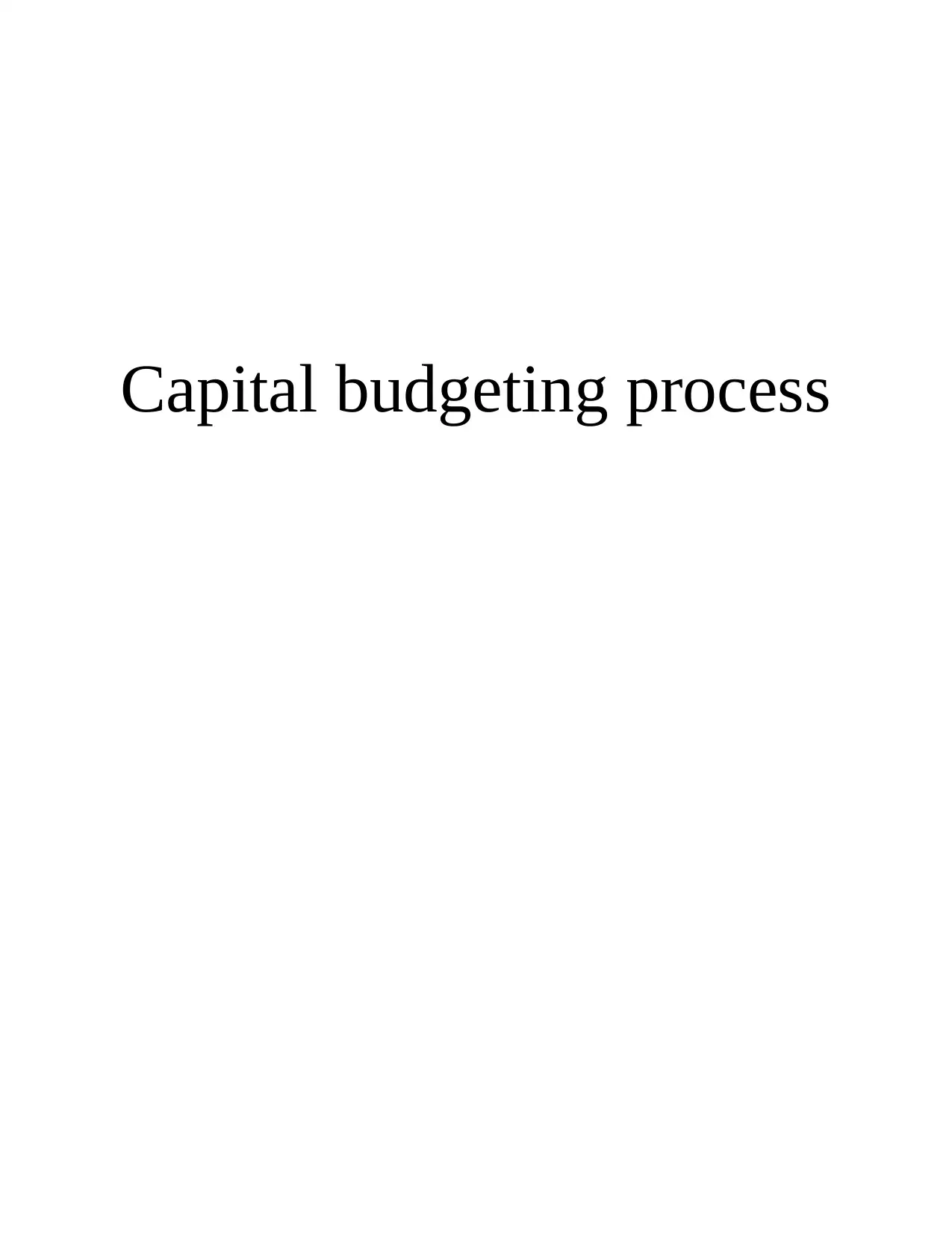
Capital budgeting process
Paraphrase This Document
Need a fresh take? Get an instant paraphrase of this document with our AI Paraphraser
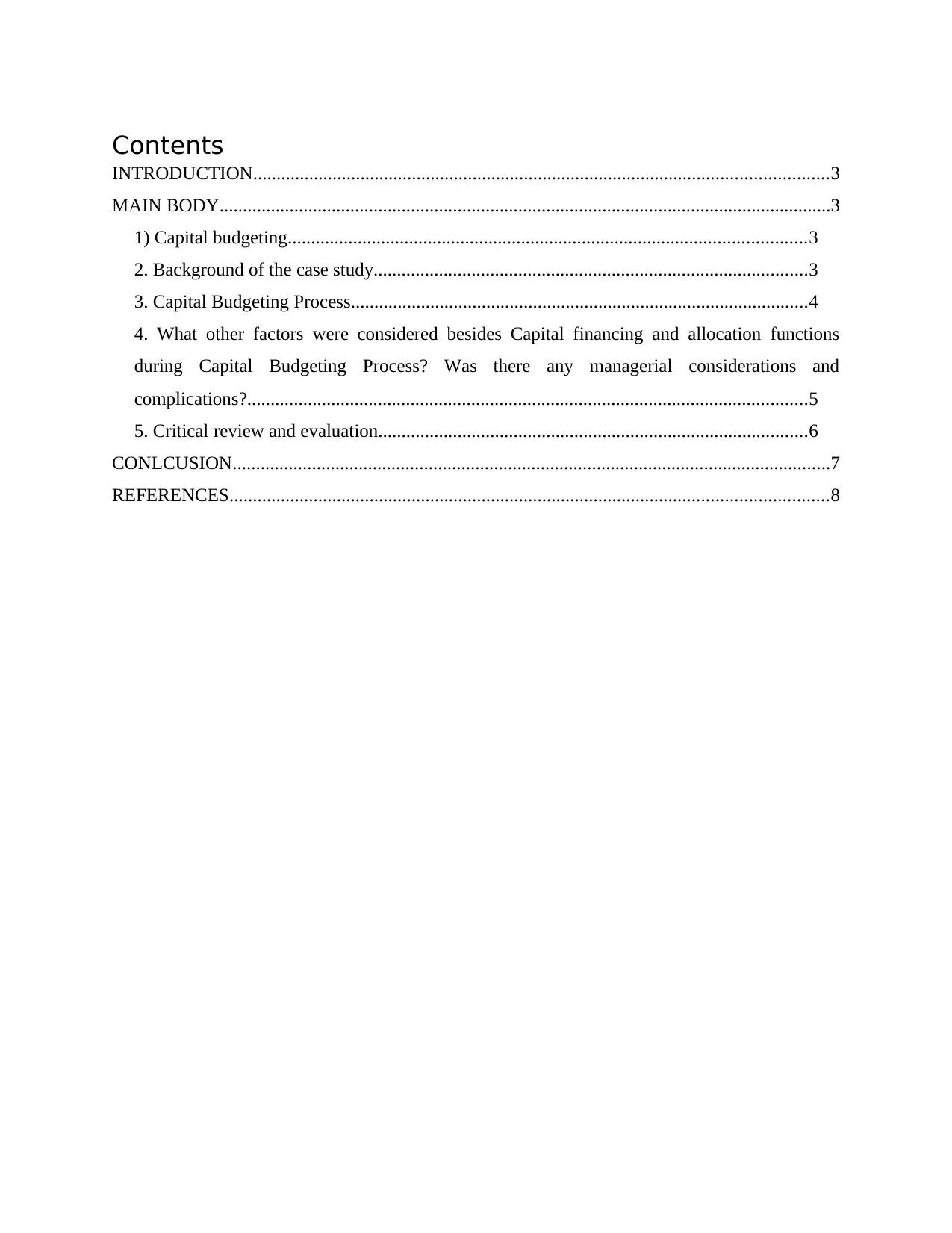
Contents
INTRODUCTION...........................................................................................................................3
MAIN BODY...................................................................................................................................3
1) Capital budgeting...............................................................................................................3
2. Background of the case study.............................................................................................3
3. Capital Budgeting Process..................................................................................................4
4. What other factors were considered besides Capital financing and allocation functions
during Capital Budgeting Process? Was there any managerial considerations and
complications?........................................................................................................................5
5. Critical review and evaluation............................................................................................6
CONLCUSION................................................................................................................................7
REFERENCES................................................................................................................................8
INTRODUCTION...........................................................................................................................3
MAIN BODY...................................................................................................................................3
1) Capital budgeting...............................................................................................................3
2. Background of the case study.............................................................................................3
3. Capital Budgeting Process..................................................................................................4
4. What other factors were considered besides Capital financing and allocation functions
during Capital Budgeting Process? Was there any managerial considerations and
complications?........................................................................................................................5
5. Critical review and evaluation............................................................................................6
CONLCUSION................................................................................................................................7
REFERENCES................................................................................................................................8
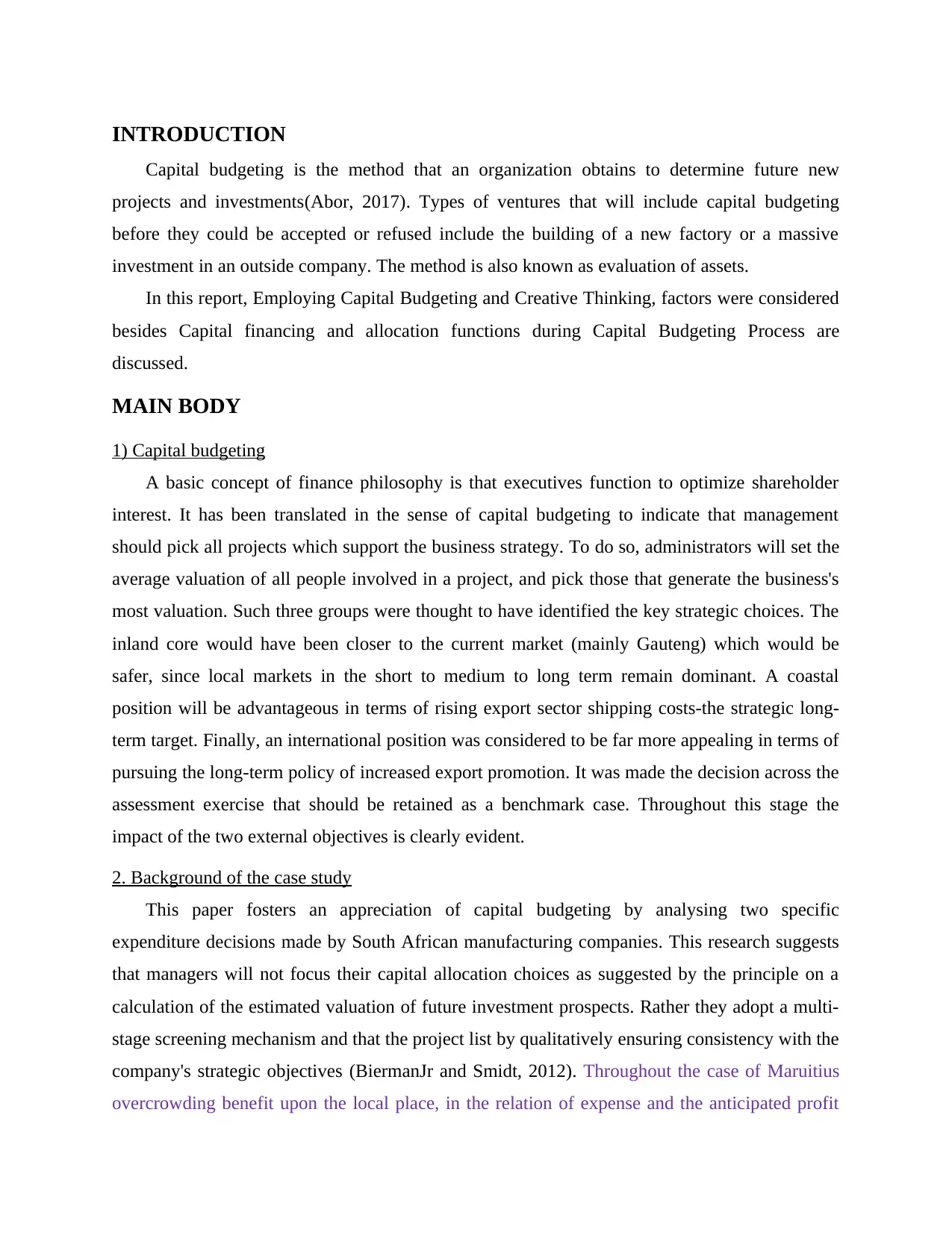
INTRODUCTION
Capital budgeting is the method that an organization obtains to determine future new
projects and investments(Abor, 2017). Types of ventures that will include capital budgeting
before they could be accepted or refused include the building of a new factory or a massive
investment in an outside company. The method is also known as evaluation of assets.
In this report, Employing Capital Budgeting and Creative Thinking, factors were considered
besides Capital financing and allocation functions during Capital Budgeting Process are
discussed.
MAIN BODY
1) Capital budgeting
A basic concept of finance philosophy is that executives function to optimize shareholder
interest. It has been translated in the sense of capital budgeting to indicate that management
should pick all projects which support the business strategy. To do so, administrators will set the
average valuation of all people involved in a project, and pick those that generate the business's
most valuation. Such three groups were thought to have identified the key strategic choices. The
inland core would have been closer to the current market (mainly Gauteng) which would be
safer, since local markets in the short to medium to long term remain dominant. A coastal
position will be advantageous in terms of rising export sector shipping costs-the strategic long-
term target. Finally, an international position was considered to be far more appealing in terms of
pursuing the long-term policy of increased export promotion. It was made the decision across the
assessment exercise that should be retained as a benchmark case. Throughout this stage the
impact of the two external objectives is clearly evident.
2. Background of the case study
This paper fosters an appreciation of capital budgeting by analysing two specific
expenditure decisions made by South African manufacturing companies. This research suggests
that managers will not focus their capital allocation choices as suggested by the principle on a
calculation of the estimated valuation of future investment prospects. Rather they adopt a multi-
stage screening mechanism and that the project list by qualitatively ensuring consistency with the
company's strategic objectives (BiermanJr and Smidt, 2012). Throughout the case of Maruitius
overcrowding benefit upon the local place, in the relation of expense and the anticipated profit
Capital budgeting is the method that an organization obtains to determine future new
projects and investments(Abor, 2017). Types of ventures that will include capital budgeting
before they could be accepted or refused include the building of a new factory or a massive
investment in an outside company. The method is also known as evaluation of assets.
In this report, Employing Capital Budgeting and Creative Thinking, factors were considered
besides Capital financing and allocation functions during Capital Budgeting Process are
discussed.
MAIN BODY
1) Capital budgeting
A basic concept of finance philosophy is that executives function to optimize shareholder
interest. It has been translated in the sense of capital budgeting to indicate that management
should pick all projects which support the business strategy. To do so, administrators will set the
average valuation of all people involved in a project, and pick those that generate the business's
most valuation. Such three groups were thought to have identified the key strategic choices. The
inland core would have been closer to the current market (mainly Gauteng) which would be
safer, since local markets in the short to medium to long term remain dominant. A coastal
position will be advantageous in terms of rising export sector shipping costs-the strategic long-
term target. Finally, an international position was considered to be far more appealing in terms of
pursuing the long-term policy of increased export promotion. It was made the decision across the
assessment exercise that should be retained as a benchmark case. Throughout this stage the
impact of the two external objectives is clearly evident.
2. Background of the case study
This paper fosters an appreciation of capital budgeting by analysing two specific
expenditure decisions made by South African manufacturing companies. This research suggests
that managers will not focus their capital allocation choices as suggested by the principle on a
calculation of the estimated valuation of future investment prospects. Rather they adopt a multi-
stage screening mechanism and that the project list by qualitatively ensuring consistency with the
company's strategic objectives (BiermanJr and Smidt, 2012). Throughout the case of Maruitius
overcrowding benefit upon the local place, in the relation of expense and the anticipated profit
⊘ This is a preview!⊘
Do you want full access?
Subscribe today to unlock all pages.

Trusted by 1+ million students worldwide
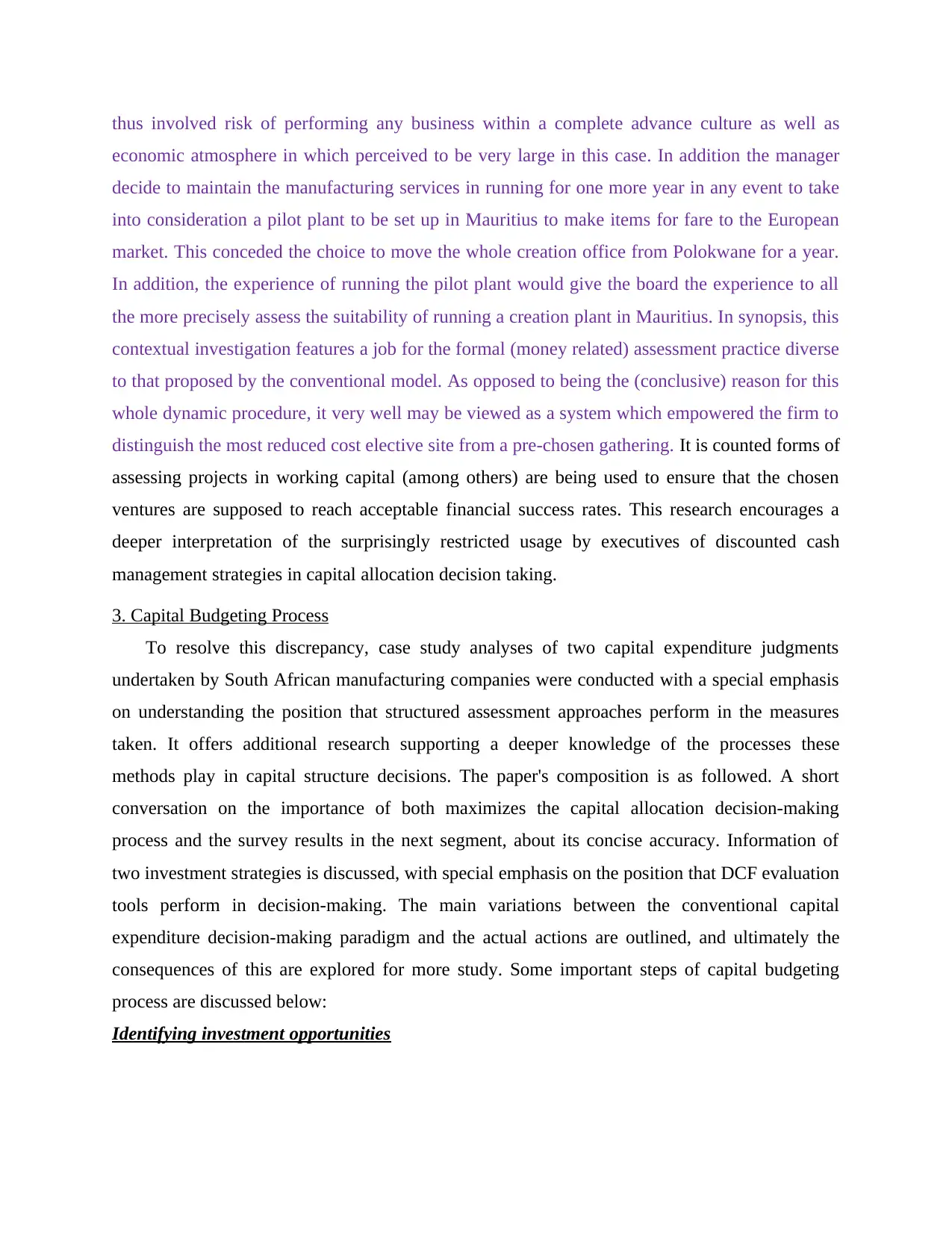
thus involved risk of performing any business within a complete advance culture as well as
economic atmosphere in which perceived to be very large in this case. In addition the manager
decide to maintain the manufacturing services in running for one more year in any event to take
into consideration a pilot plant to be set up in Mauritius to make items for fare to the European
market. This conceded the choice to move the whole creation office from Polokwane for a year.
In addition, the experience of running the pilot plant would give the board the experience to all
the more precisely assess the suitability of running a creation plant in Mauritius. In synopsis, this
contextual investigation features a job for the formal (money related) assessment practice diverse
to that proposed by the conventional model. As opposed to being the (conclusive) reason for this
whole dynamic procedure, it very well may be viewed as a system which empowered the firm to
distinguish the most reduced cost elective site from a pre-chosen gathering. It is counted forms of
assessing projects in working capital (among others) are being used to ensure that the chosen
ventures are supposed to reach acceptable financial success rates. This research encourages a
deeper interpretation of the surprisingly restricted usage by executives of discounted cash
management strategies in capital allocation decision taking.
3. Capital Budgeting Process
To resolve this discrepancy, case study analyses of two capital expenditure judgments
undertaken by South African manufacturing companies were conducted with a special emphasis
on understanding the position that structured assessment approaches perform in the measures
taken. It offers additional research supporting a deeper knowledge of the processes these
methods play in capital structure decisions. The paper's composition is as followed. A short
conversation on the importance of both maximizes the capital allocation decision-making
process and the survey results in the next segment, about its concise accuracy. Information of
two investment strategies is discussed, with special emphasis on the position that DCF evaluation
tools perform in decision-making. The main variations between the conventional capital
expenditure decision-making paradigm and the actual actions are outlined, and ultimately the
consequences of this are explored for more study. Some important steps of capital budgeting
process are discussed below:
Identifying investment opportunities
economic atmosphere in which perceived to be very large in this case. In addition the manager
decide to maintain the manufacturing services in running for one more year in any event to take
into consideration a pilot plant to be set up in Mauritius to make items for fare to the European
market. This conceded the choice to move the whole creation office from Polokwane for a year.
In addition, the experience of running the pilot plant would give the board the experience to all
the more precisely assess the suitability of running a creation plant in Mauritius. In synopsis, this
contextual investigation features a job for the formal (money related) assessment practice diverse
to that proposed by the conventional model. As opposed to being the (conclusive) reason for this
whole dynamic procedure, it very well may be viewed as a system which empowered the firm to
distinguish the most reduced cost elective site from a pre-chosen gathering. It is counted forms of
assessing projects in working capital (among others) are being used to ensure that the chosen
ventures are supposed to reach acceptable financial success rates. This research encourages a
deeper interpretation of the surprisingly restricted usage by executives of discounted cash
management strategies in capital allocation decision taking.
3. Capital Budgeting Process
To resolve this discrepancy, case study analyses of two capital expenditure judgments
undertaken by South African manufacturing companies were conducted with a special emphasis
on understanding the position that structured assessment approaches perform in the measures
taken. It offers additional research supporting a deeper knowledge of the processes these
methods play in capital structure decisions. The paper's composition is as followed. A short
conversation on the importance of both maximizes the capital allocation decision-making
process and the survey results in the next segment, about its concise accuracy. Information of
two investment strategies is discussed, with special emphasis on the position that DCF evaluation
tools perform in decision-making. The main variations between the conventional capital
expenditure decision-making paradigm and the actual actions are outlined, and ultimately the
consequences of this are explored for more study. Some important steps of capital budgeting
process are discussed below:
Identifying investment opportunities
Paraphrase This Document
Need a fresh take? Get an instant paraphrase of this document with our AI Paraphraser
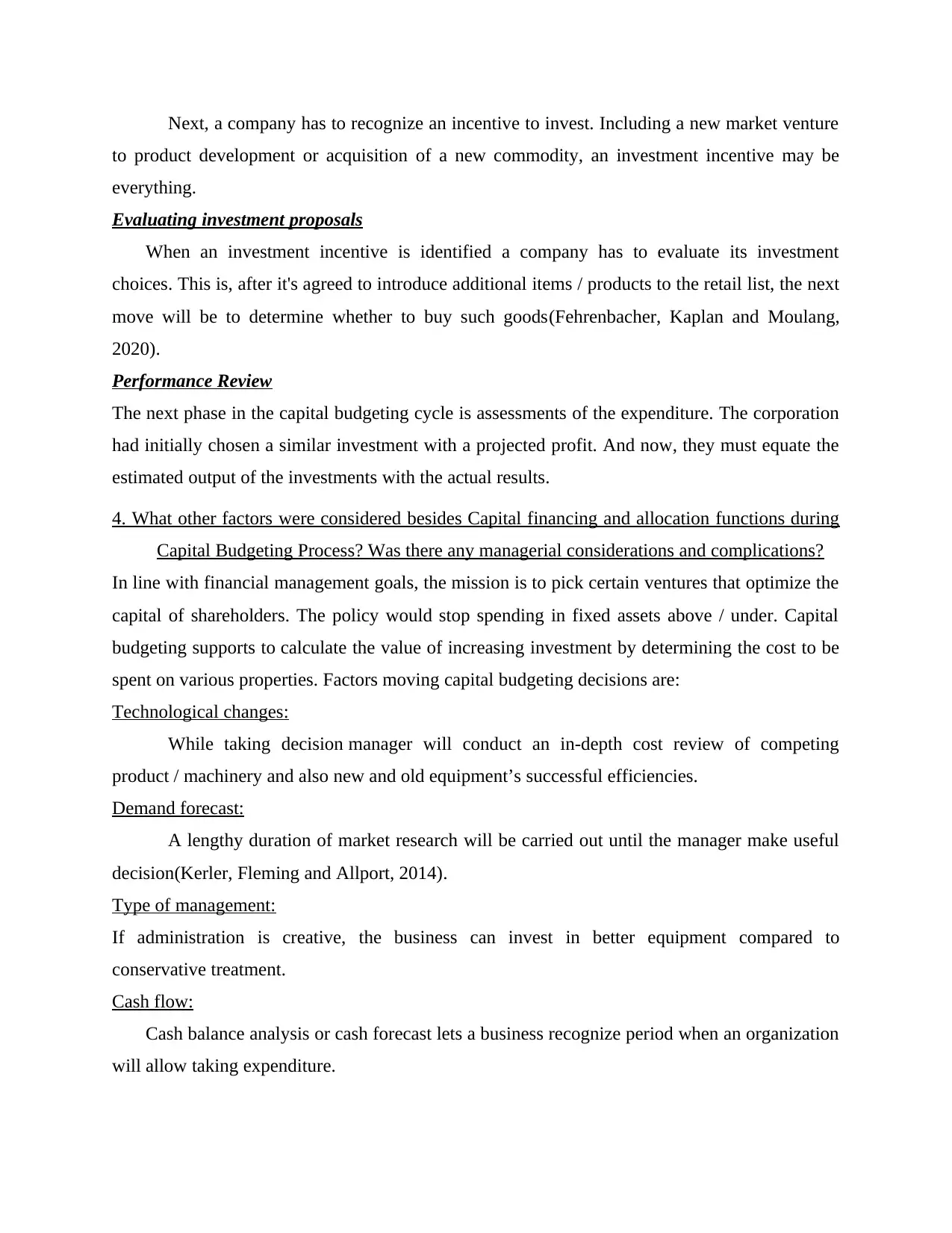
Next, a company has to recognize an incentive to invest. Including a new market venture
to product development or acquisition of a new commodity, an investment incentive may be
everything.
Evaluating investment proposals
When an investment incentive is identified a company has to evaluate its investment
choices. This is, after it's agreed to introduce additional items / products to the retail list, the next
move will be to determine whether to buy such goods(Fehrenbacher, Kaplan and Moulang,
2020).
Performance Review
The next phase in the capital budgeting cycle is assessments of the expenditure. The corporation
had initially chosen a similar investment with a projected profit. And now, they must equate the
estimated output of the investments with the actual results.
4. What other factors were considered besides Capital financing and allocation functions during
Capital Budgeting Process? Was there any managerial considerations and complications?
In line with financial management goals, the mission is to pick certain ventures that optimize the
capital of shareholders. The policy would stop spending in fixed assets above / under. Capital
budgeting supports to calculate the value of increasing investment by determining the cost to be
spent on various properties. Factors moving capital budgeting decisions are:
Technological changes:
While taking decision manager will conduct an in-depth cost review of competing
product / machinery and also new and old equipment’s successful efficiencies.
Demand forecast:
A lengthy duration of market research will be carried out until the manager make useful
decision(Kerler, Fleming and Allport, 2014).
Type of management:
If administration is creative, the business can invest in better equipment compared to
conservative treatment.
Cash flow:
Cash balance analysis or cash forecast lets a business recognize period when an organization
will allow taking expenditure.
to product development or acquisition of a new commodity, an investment incentive may be
everything.
Evaluating investment proposals
When an investment incentive is identified a company has to evaluate its investment
choices. This is, after it's agreed to introduce additional items / products to the retail list, the next
move will be to determine whether to buy such goods(Fehrenbacher, Kaplan and Moulang,
2020).
Performance Review
The next phase in the capital budgeting cycle is assessments of the expenditure. The corporation
had initially chosen a similar investment with a projected profit. And now, they must equate the
estimated output of the investments with the actual results.
4. What other factors were considered besides Capital financing and allocation functions during
Capital Budgeting Process? Was there any managerial considerations and complications?
In line with financial management goals, the mission is to pick certain ventures that optimize the
capital of shareholders. The policy would stop spending in fixed assets above / under. Capital
budgeting supports to calculate the value of increasing investment by determining the cost to be
spent on various properties. Factors moving capital budgeting decisions are:
Technological changes:
While taking decision manager will conduct an in-depth cost review of competing
product / machinery and also new and old equipment’s successful efficiencies.
Demand forecast:
A lengthy duration of market research will be carried out until the manager make useful
decision(Kerler, Fleming and Allport, 2014).
Type of management:
If administration is creative, the business can invest in better equipment compared to
conservative treatment.
Cash flow:
Cash balance analysis or cash forecast lets a business recognize period when an organization
will allow taking expenditure.
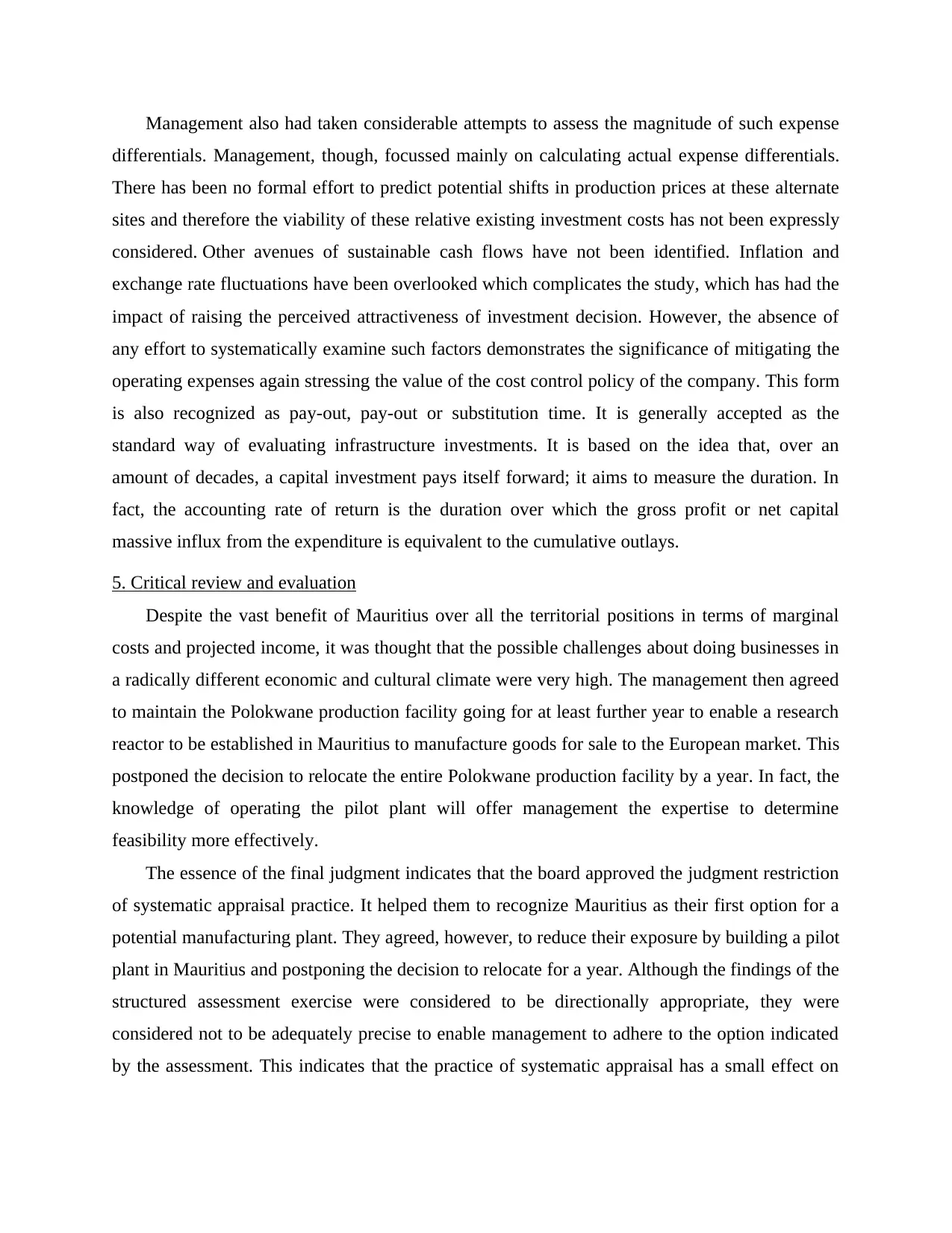
Management also had taken considerable attempts to assess the magnitude of such expense
differentials. Management, though, focussed mainly on calculating actual expense differentials.
There has been no formal effort to predict potential shifts in production prices at these alternate
sites and therefore the viability of these relative existing investment costs has not been expressly
considered. Other avenues of sustainable cash flows have not been identified. Inflation and
exchange rate fluctuations have been overlooked which complicates the study, which has had the
impact of raising the perceived attractiveness of investment decision. However, the absence of
any effort to systematically examine such factors demonstrates the significance of mitigating the
operating expenses again stressing the value of the cost control policy of the company. This form
is also recognized as pay-out, pay-out or substitution time. It is generally accepted as the
standard way of evaluating infrastructure investments. It is based on the idea that, over an
amount of decades, a capital investment pays itself forward; it aims to measure the duration. In
fact, the accounting rate of return is the duration over which the gross profit or net capital
massive influx from the expenditure is equivalent to the cumulative outlays.
5. Critical review and evaluation
Despite the vast benefit of Mauritius over all the territorial positions in terms of marginal
costs and projected income, it was thought that the possible challenges about doing businesses in
a radically different economic and cultural climate were very high. The management then agreed
to maintain the Polokwane production facility going for at least further year to enable a research
reactor to be established in Mauritius to manufacture goods for sale to the European market. This
postponed the decision to relocate the entire Polokwane production facility by a year. In fact, the
knowledge of operating the pilot plant will offer management the expertise to determine
feasibility more effectively.
The essence of the final judgment indicates that the board approved the judgment restriction
of systematic appraisal practice. It helped them to recognize Mauritius as their first option for a
potential manufacturing plant. They agreed, however, to reduce their exposure by building a pilot
plant in Mauritius and postponing the decision to relocate for a year. Although the findings of the
structured assessment exercise were considered to be directionally appropriate, they were
considered not to be adequately precise to enable management to adhere to the option indicated
by the assessment. This indicates that the practice of systematic appraisal has a small effect on
differentials. Management, though, focussed mainly on calculating actual expense differentials.
There has been no formal effort to predict potential shifts in production prices at these alternate
sites and therefore the viability of these relative existing investment costs has not been expressly
considered. Other avenues of sustainable cash flows have not been identified. Inflation and
exchange rate fluctuations have been overlooked which complicates the study, which has had the
impact of raising the perceived attractiveness of investment decision. However, the absence of
any effort to systematically examine such factors demonstrates the significance of mitigating the
operating expenses again stressing the value of the cost control policy of the company. This form
is also recognized as pay-out, pay-out or substitution time. It is generally accepted as the
standard way of evaluating infrastructure investments. It is based on the idea that, over an
amount of decades, a capital investment pays itself forward; it aims to measure the duration. In
fact, the accounting rate of return is the duration over which the gross profit or net capital
massive influx from the expenditure is equivalent to the cumulative outlays.
5. Critical review and evaluation
Despite the vast benefit of Mauritius over all the territorial positions in terms of marginal
costs and projected income, it was thought that the possible challenges about doing businesses in
a radically different economic and cultural climate were very high. The management then agreed
to maintain the Polokwane production facility going for at least further year to enable a research
reactor to be established in Mauritius to manufacture goods for sale to the European market. This
postponed the decision to relocate the entire Polokwane production facility by a year. In fact, the
knowledge of operating the pilot plant will offer management the expertise to determine
feasibility more effectively.
The essence of the final judgment indicates that the board approved the judgment restriction
of systematic appraisal practice. It helped them to recognize Mauritius as their first option for a
potential manufacturing plant. They agreed, however, to reduce their exposure by building a pilot
plant in Mauritius and postponing the decision to relocate for a year. Although the findings of the
structured assessment exercise were considered to be directionally appropriate, they were
considered not to be adequately precise to enable management to adhere to the option indicated
by the assessment. This indicates that the practice of systematic appraisal has a small effect on
⊘ This is a preview!⊘
Do you want full access?
Subscribe today to unlock all pages.

Trusted by 1+ million students worldwide
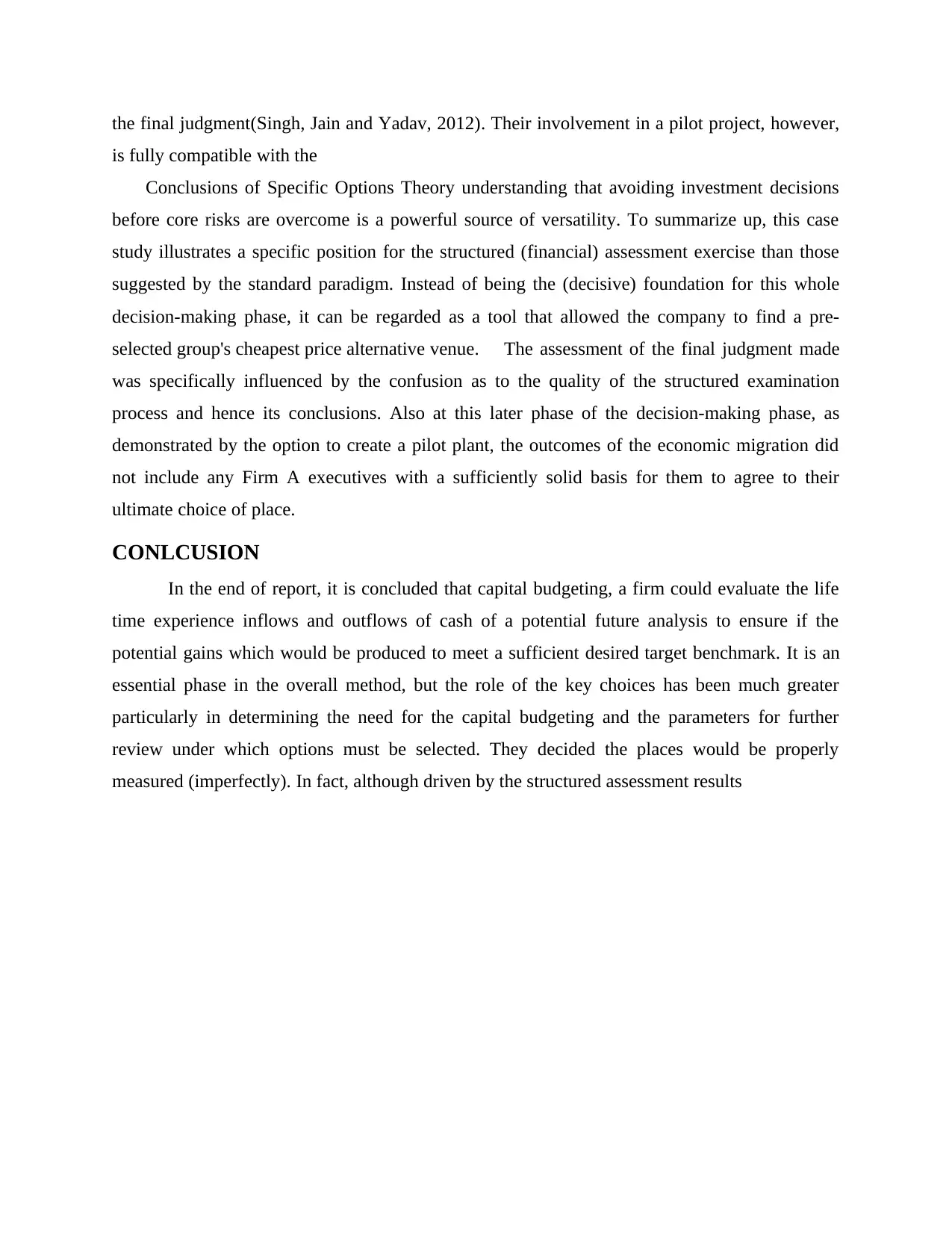
the final judgment(Singh, Jain and Yadav, 2012). Their involvement in a pilot project, however,
is fully compatible with the
Conclusions of Specific Options Theory understanding that avoiding investment decisions
before core risks are overcome is a powerful source of versatility. To summarize up, this case
study illustrates a specific position for the structured (financial) assessment exercise than those
suggested by the standard paradigm. Instead of being the (decisive) foundation for this whole
decision-making phase, it can be regarded as a tool that allowed the company to find a pre-
selected group's cheapest price alternative venue. The assessment of the final judgment made
was specifically influenced by the confusion as to the quality of the structured examination
process and hence its conclusions. Also at this later phase of the decision-making phase, as
demonstrated by the option to create a pilot plant, the outcomes of the economic migration did
not include any Firm A executives with a sufficiently solid basis for them to agree to their
ultimate choice of place.
CONLCUSION
In the end of report, it is concluded that capital budgeting, a firm could evaluate the life
time experience inflows and outflows of cash of a potential future analysis to ensure if the
potential gains which would be produced to meet a sufficient desired target benchmark. It is an
essential phase in the overall method, but the role of the key choices has been much greater
particularly in determining the need for the capital budgeting and the parameters for further
review under which options must be selected. They decided the places would be properly
measured (imperfectly). In fact, although driven by the structured assessment results
is fully compatible with the
Conclusions of Specific Options Theory understanding that avoiding investment decisions
before core risks are overcome is a powerful source of versatility. To summarize up, this case
study illustrates a specific position for the structured (financial) assessment exercise than those
suggested by the standard paradigm. Instead of being the (decisive) foundation for this whole
decision-making phase, it can be regarded as a tool that allowed the company to find a pre-
selected group's cheapest price alternative venue. The assessment of the final judgment made
was specifically influenced by the confusion as to the quality of the structured examination
process and hence its conclusions. Also at this later phase of the decision-making phase, as
demonstrated by the option to create a pilot plant, the outcomes of the economic migration did
not include any Firm A executives with a sufficiently solid basis for them to agree to their
ultimate choice of place.
CONLCUSION
In the end of report, it is concluded that capital budgeting, a firm could evaluate the life
time experience inflows and outflows of cash of a potential future analysis to ensure if the
potential gains which would be produced to meet a sufficient desired target benchmark. It is an
essential phase in the overall method, but the role of the key choices has been much greater
particularly in determining the need for the capital budgeting and the parameters for further
review under which options must be selected. They decided the places would be properly
measured (imperfectly). In fact, although driven by the structured assessment results
Paraphrase This Document
Need a fresh take? Get an instant paraphrase of this document with our AI Paraphraser
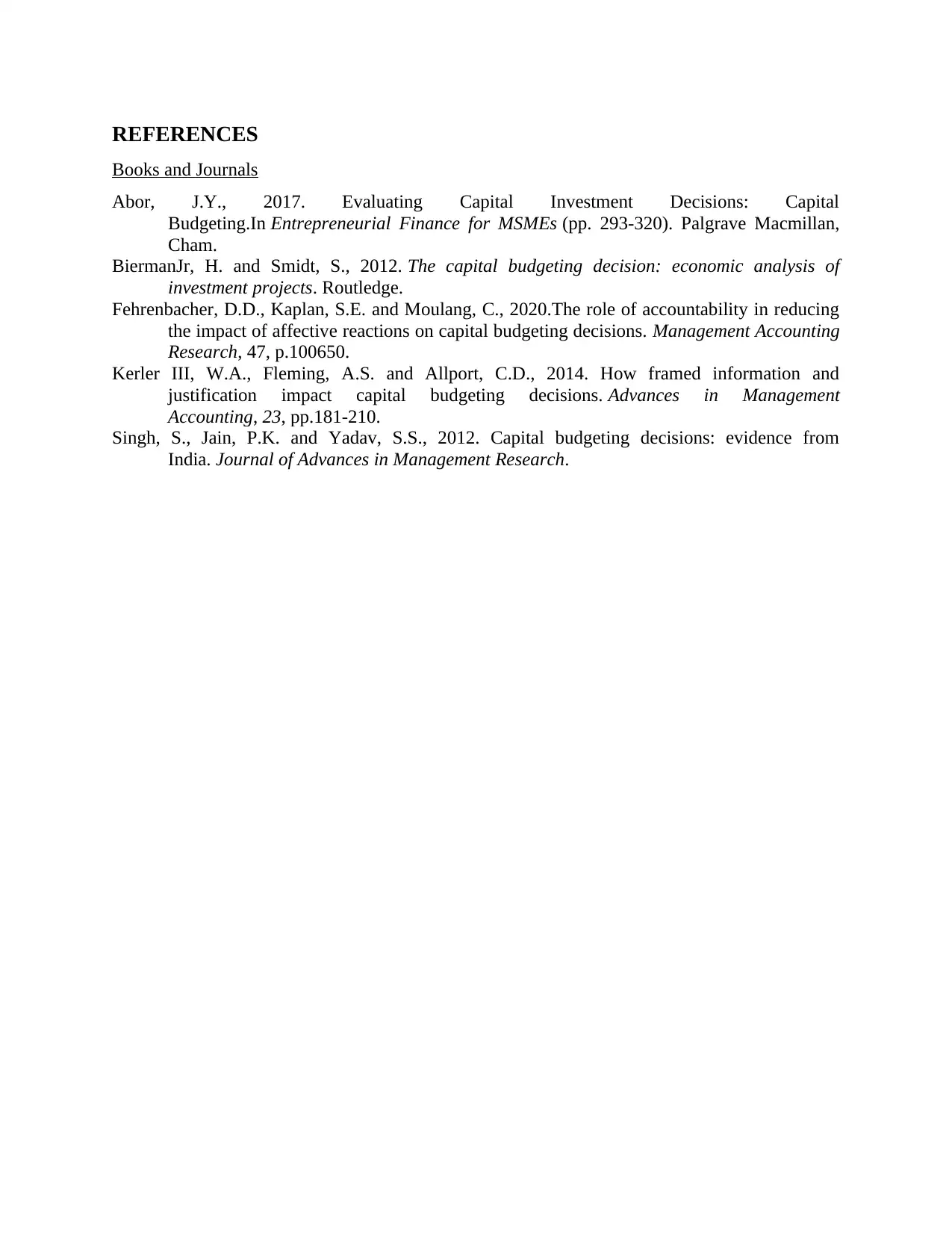
REFERENCES
Books and Journals
Abor, J.Y., 2017. Evaluating Capital Investment Decisions: Capital
Budgeting.In Entrepreneurial Finance for MSMEs (pp. 293-320). Palgrave Macmillan,
Cham.
BiermanJr, H. and Smidt, S., 2012. The capital budgeting decision: economic analysis of
investment projects. Routledge.
Fehrenbacher, D.D., Kaplan, S.E. and Moulang, C., 2020.The role of accountability in reducing
the impact of affective reactions on capital budgeting decisions. Management Accounting
Research, 47, p.100650.
Kerler III, W.A., Fleming, A.S. and Allport, C.D., 2014. How framed information and
justification impact capital budgeting decisions. Advances in Management
Accounting, 23, pp.181-210.
Singh, S., Jain, P.K. and Yadav, S.S., 2012. Capital budgeting decisions: evidence from
India. Journal of Advances in Management Research.
Books and Journals
Abor, J.Y., 2017. Evaluating Capital Investment Decisions: Capital
Budgeting.In Entrepreneurial Finance for MSMEs (pp. 293-320). Palgrave Macmillan,
Cham.
BiermanJr, H. and Smidt, S., 2012. The capital budgeting decision: economic analysis of
investment projects. Routledge.
Fehrenbacher, D.D., Kaplan, S.E. and Moulang, C., 2020.The role of accountability in reducing
the impact of affective reactions on capital budgeting decisions. Management Accounting
Research, 47, p.100650.
Kerler III, W.A., Fleming, A.S. and Allport, C.D., 2014. How framed information and
justification impact capital budgeting decisions. Advances in Management
Accounting, 23, pp.181-210.
Singh, S., Jain, P.K. and Yadav, S.S., 2012. Capital budgeting decisions: evidence from
India. Journal of Advances in Management Research.
1 out of 8
Related Documents
Your All-in-One AI-Powered Toolkit for Academic Success.
+13062052269
info@desklib.com
Available 24*7 on WhatsApp / Email
![[object Object]](/_next/static/media/star-bottom.7253800d.svg)
Unlock your academic potential
Copyright © 2020–2025 A2Z Services. All Rights Reserved. Developed and managed by ZUCOL.





